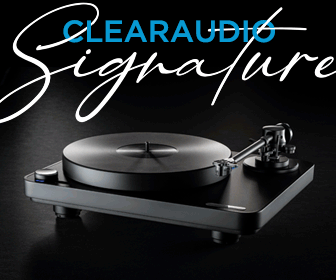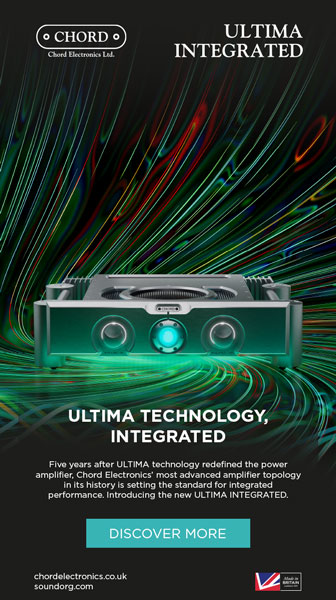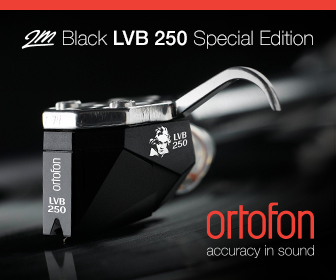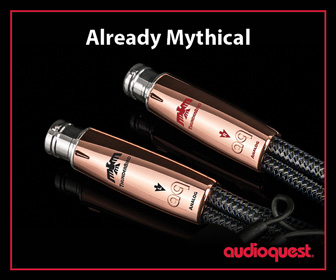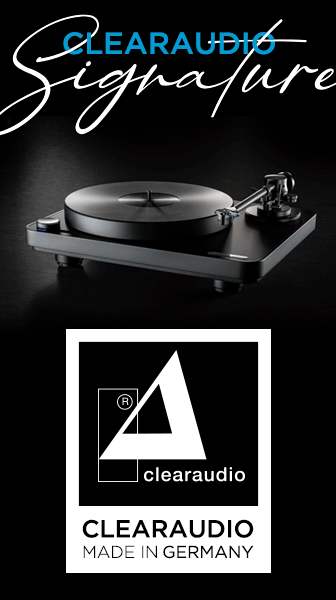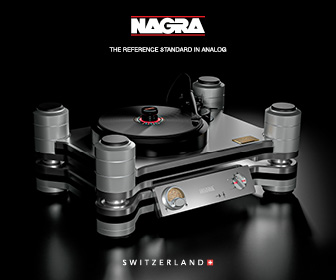LINA DAC/Streamer Lowers dCS Entry Price But Not Performance Quality
"the reigning brand in British digital electronics" turns Mr. Kennedy's ears
I have an admission to make, in all the demonstrations of dCS products that I have attended none have inspired me to listen further. They have always sounded perfect but devoid of involvement. However, this product and by extension the need to investigate its various set up options has revealed that dCS DACs are distinctly better than I thought. And this is only the baby in the range.
By most metrics dCS is the reigning brand in British digital electronics. No one else comes close in terms of luxury build and dedication to a single cause: getting the very best sound out of digital audio. Whether they lead the way in terms of technology stirs up more argument from other ambitious players in this sector but they are certainly in the top three when it comes to pushing the digital envelope. This summer dCS launched their most ambitious system yet and named it after Frank Zapper’s favorite composer, Edgar Varèse, presumably not just because the sirens he included in arrangements sound particularly convincing with their gear, but I imagine that they do.
The dCS component under consideration here is from the opposite end of the scale, the LINA Network DAC is the least expensive converter that the company makes and even then it’s hardly inexpensive at $13,650. This DAC is also a streamer, hence Network in its name, and forms the core of the LINA headphone system, which also includes the Master Clock and Headphone Amplifier. All three elements inhabit the same squat black casework, the Network DAC being distinguished by its black and white touch screen, albeit the touch sensitivity only applies to a certain part of that display.
The Network DAC is both bigger and heavier than it looks, while only half width it weighs more than many full width converters and stands higher thanks to a plinth that’s just over ¾ inch high (20mm) and has thick rubber pads on its base. This plinth feels like it adds a good deal of the overall mass and acts as a sink for internal vibration and, to some extent, a barrier to vibration in the supporting stand. Auralic use a machined base on their devices in order to provide rigidity as a means of combatting vibration and the dCS approach is similar.
Connection options for digital sources are pretty comprehensive with coaxial SPDIF on both RCA and BNC and the optical variant on Toslink, then two AES inputs and a USB. The only omission is the lesser spotted ST optical input. The USB A socket is for attaching a hard drive while the network socket is where the LINA gets its connection to the wider world via the Internet, including, of course local NAS storage and streaming services including Qobuz, Tidal, Spotify and Airplay. On the output side the Lina has the usual RCA and balanced XLR options above a pair of RJ45 sockets marked Power Link which is the dCS system for triggering other components to switch on and off simultaneously. The final connections are a pair of BNC sockets for attaching a wordclock, the LINA Master Clock has a matching pair of outputs with one dedicated to 44.1 kHz and multiples thereof and the other to 48 kHz.
The converter within the LINA is the Ring DAC that first saw consumer audio use in the Elgar in 1996. The technology was first used in audio products in their professional ADCs in the late eighties. The Ring DAC was designed to virtually eliminate distortion at the expense of a small amount of switching noise and to deliver maximum linearity of input to output signals. It is a high speed hybrid of bitstream and multibit technologies that is discretely built using an array of 48 identical current sources of which a maximum of 32 need be used at any one time. The remaining 16 provide the ability to cycle the current sources being used for subsequent samples in a ring like fashion, hence the name. All incoming signals are modulated to ~3MHz or ~6MHz and 5-bits prior to conversion, hence there is no option for non-oversampling in the broad array of set up choices within the LINA.
What you can choose between are two levels of DSD upsampling, (single or double speed), and DXD (PCM at 352kHz or 384kHz). You can also select from different Mapper options, this being the algorithm that chooses which of the current sources to use for converting each audio sample, there are three mapper settings to choose from and I was advised by David J Stevens from dCS that “Mapper 1 > DSD x 2 > F5 setting is ideal we think for listener who likes a natural, unforced and open sound… some filters offer excellent out of band rejection at the expense of time-domain performance so if your bag is more timing, impact and rhythm, try Mapper 3 > DXD and F3.” He must have had some idea of where my tastes are at because timing is very much my cup of tea, it’s the main area where digital lags behind analogue in my book and also the area where I have found dCS products to be lacking in the past.
There are multiple filter options for both PCM and DSD, seven and five respectively, four crossfeed settings for headphone users, and the option to run with the buffer on or off. I have not seen multiple output voltage options on a DAC before but this offers four from 0.2V to 6V, making it very easy to balance out preamplifiers/amps with too little or too much gain (tube amp users take note). There are no fewer than five sync modes for use with onboard, signal based or external clocking. You can adjust all of the settings via the screen on the LINA but not by touching the graphics, the only touch sensitive elements are on the row of lights at the bottom, these allow access to various menus where selections can be made. A much easier way of changing things is to connect it to the network and use the dCS Mosaic app, this gives access to all the variables as well as being a control app for the unit’s streaming functionality. I tried to use my preferred streaming app, JPlay, but it this wasn’t a happy partnership so I went back to Mosaic which while fairly straightforward and hardly feature rich is reliable and consistent. You can of course run the LINA with Roon should that be your bag.
Sound Quality
Initially I placed this network DAC into a shelf that left it about half an inch of headroom, however I noticed that it gets pretty hot for a converter so it moved into a bigger space. It took a few moments to get it running because while there’s a power switch on the back there is also a small standby switch hidden under the front, but that sort of thing isn’t entirely unheard of. Initially I connected a USB cable from a modified Lumin U2 Mini streamer to the Lina and used it purely as a DAC and have to say that the results were rather appealing, this converter has a richer balance than average but is by no means soft or smoothing, in fact it is very revealing indeed and reaches with apparent ease the parts to which more affordable alternatives fail. For the first day of audition I still had the mighty Vivid Moya M1 speakers in the system and they are not sparing when it comes to exposing the nature of the signal, I have to say that the LINA stood up to the scrutiny extremely well, extracting not only the detail but also the emotional quotient alongside it. This is an area where many DACs fall down and concede ground to their black vinyl spinning competitors so it was gratifying to find that this smallest of the dCS converters knew how to dig into this particular musical seam.
As hinted at above it also timed rather well and the combination with these particular loudspeakers had me jumping about like Flat Eric (you remember the head banging puppet that advertised Levis back in the day, no doubt). Suffice to say that the pairing laid down a very solid groove thanks to deep, juicy bass and a fulsome almost fruity quality in recordings that contains such characteristics. Bobby Womack’s superb rendition of "Fire and Rain" (Communication) on the other hand is a very hot recording with remarkable presence and immediacy, it nearly brought a tear to my eye.
Back in the real world with Kaya S12 speakers from the very bottom of the Vivid range I was impressed by the way that the LINA coped with the raucous beats of drum and bass classic "Brown Paper Bag" (Roni Size & Reprazent), and delivered them in a coherent and engaging fashion without emphasizing the crudeness of the production. This tune requires a source that can deliver transients in a clean and precise manner with the minimum of time smear and the LINA delivers the goods. Its slight smoothness becomes apparent with the attacking steel string acoustic guitar of Fred Frith on "Hard Time Killing Floor Blues". This doesn’t have quite the clarity that it can, but in retrospect I realized that using the LINA as a streamer delivers the result I was looking for, and allows more explicit for recordings like this to be delivered complete with musical grit.
With the somewhat more polished creation that is, "It Ain’t Necessarily" So by Herbie Hancock (Gershwin’s World) the LINA is very good at resolving the tones of brass and piano, each having its own distinct timbre and the whole band remaining locked in synch thanks to the timing qualities provided by the DAC. Moving over to the LINA as both a streamer and DAC and bypassing the Lumin does result in a shortfall in three dimensionality and ease of presentation but the LINA alone has more snap and defines leading edges with considerable precision. It’s certainly no slouch as a streamer and I used it for some time in this guise and enjoyed a wide range of music including older albums such as Nina Simone’s ‘Nuff Said. This is not the smoothest of recordings but the artist’s force of character makes it extremely engaging. The LINA managing to avoid emphasizing the shortcomings of the production in favor of the quality of performance.
Verdict
The dCS LINA is a neutrally balanced and even-handed network DAC, it’s not as sweet in the highs as some of its more colorful competitors but very good at separating out the musical strands in any piece of music. It is also hard to faze, and will play the densest classical or contemporary pieces without becoming hard edged or messy, it sticks to the script and remains calm under fire. What surprised me most given earlier experiences with the brand is the way it delivers the soul of the music, it’s not romantic but if there is an emotional message in the material you will hear it, and that for me is what raises any high end component above the mainstream. I want detail and full scale imaging and the LINA provides that in spades but if the timing isn’t right and you can’t hear what the performance is really all about, then listening becomes a bit of an academic exercise, one that doesn’t hold attention. When I put on the forthcoming Tord Gustavsen release Seeing the scale, depth and heart of the music filled the room and had me in its grip. This really is what living should be all about.
TrackingAngle welcomes distinguished British audio reviewer Jason Kennedy. Jason started reviewing when he joined Hi-Fi Choice magazine for its transition from an A5 to an A4 monthly publication in 1987. By dint of persistence he was made Editor and stayed until 2001. Jason Kennedy still contributes to HFC alongside a number of audio publications. He is also editor of The ear
Specifications
LINA Network DAC
Specifications:
Product Dimensions: / Weight: 121.5mm (H) x 220mm (W) x 339mm (D) 7.4kg
Shipping Dimensions / Weight: 320mm (H) x 360mm (W) x 530mm (D) / 10.3kg
Finish: Black machined aluminium with crystal LED display
Digital Inputs:
• 2 x AES/EBU on 3 pin XLR 44.1-384kS/s
• 1 x S/PDIF BNC Coax 44.1-192kS/s
• 1 x S/PDIF on RCA 44.1-192kS/s
• 1 x Toslink 44.1-96kS/s
• 1 x USB Type B 44.1-384kS/s, PCM and DSD, DSDx2 in Async Mode
• 1 x USB Type A connector for mass storage devices (navigated using Mosaic)
Analogue Outputs:
1 stereo balanced pair on 2x 3-pin male XLR connectors (pin 2 = hot, pin 3
= cold). These outputs are electronically balanced and floating, the signal
balance ratio at 1 kHz is better than 40dB. Output impedance is 3Ω , maximum
load is 600Ω (a 10kΩ - 100kΩ load is recommended).
1 stereo unbalanced pair on 2x RCA Phono connectors. Output impedance is
52Ω, maximum load is 600Ω (a 10kΩ - 100kΩ load is recommended).
Output levels are 0.2V, 0.6V, 2V, or 6V rms for a full-scale input, set in the
menu.
Network Interface:
RJ-45 connector
Electronics:
• dCS Ring DAC and Digital Processing Platform on flex rigid PCB
• Stream Unlimited S800
• Automatic voltage switching
Streaming Compatibility:
• UPnP
• Qobuz
• Deezer
• Tidal
• Internet Radio
• Spotify
• Apple AirPlay 2 (support at 44.1 or 48kS/s)
• RoonReady
Sample frequencies and formats:
Supports the following platforms and services:
Supports the following audio formats and sample rates:
• 44.1-384kS/s up to 24 bits
• DSD/64, DSD/128
• Native DSD + DoP (input dependent)
• FLAC, WAV, AIFF, MQA
Upsampling:
Multi-stage DXD oversampling with switchable DSD Upsaampling (1-bit 2.822 or
3.07MS/s) and DSDx2 Upsampling (1-bit 5.644 or 6.14MS/s).
Word Clock:
• 2 x Word Clock inputs on 75 Ω BNC connectors
• Will lock to 44.1-192kHz
Filters:
• PCM mode: up to 6 filters give different trade-offs between the Nyquist image
rejection and the phase response
• DSD mode: 4 filters progressively reduce out-of-audio band noise level, plus
Filter 5 which has an improved transient response
Crossfeed Settings:
• Standard crossfeed
• dCS Enhanced crossfeed (E1)
• dCS Enhanced crossfeed (E2)
Power:
• IEC inlet & power switch on rear panel
• 90-127V / 220-240V, 50/60Hz, consumption 30W
• Automatic voltage switching
• Power synchronised with other dCS control link products (RJ45)
Frequency Response (set to filter 1):
• Fs = 44.1 or 48kS/s +/-0.1dB, 10Hz-20kHz
• Fs = 88.2 or 96kS/s +/-0.1dB, 10Hz-20kHz -3dB @ >38kHz
• Fs = 176.4 or 192kS/s +/-0.1dB, 10Hz-20kHz -3dB @ >67kHz
• Fs = 352.8 or 384kS/s +/-0.1dB, 10Hz-20kHz -3dB @ >100kHz
• DSD64 +/-0.1dB, 10Hz-20kHz -3dB @ >90kHz
• DSD128 +/-0.1dB, 10Hz-20kHz -3dB @ >100kHz
Residual Noise (6v output setting):
• 16-bit data: Better than –96dB0, 20Hz-20kHz unweighted
• 24-bit data: Better than –113dB0, 20Hz-20kHz unweighted
Spurious Responses:
Better than –105dB0, 20Hz-20kHz
L-R Crosstalk:
Better than –115dB0, 20Hz-20kHz
©2021







